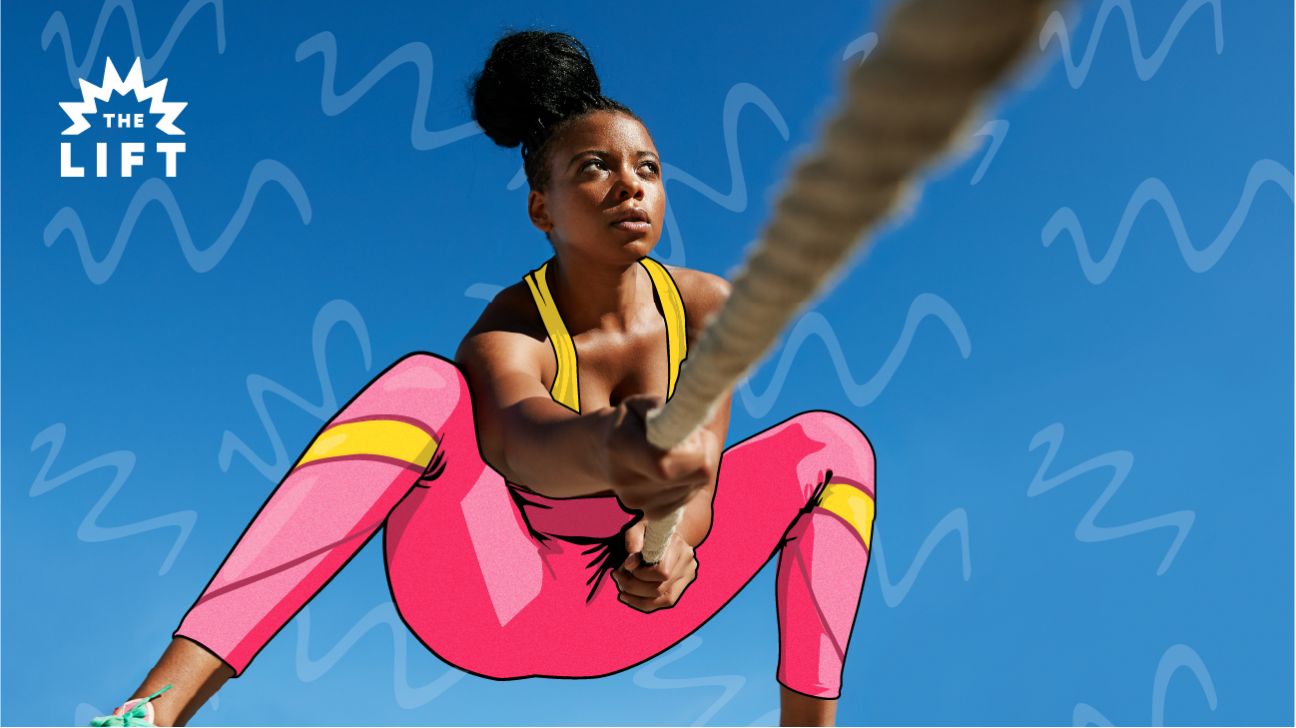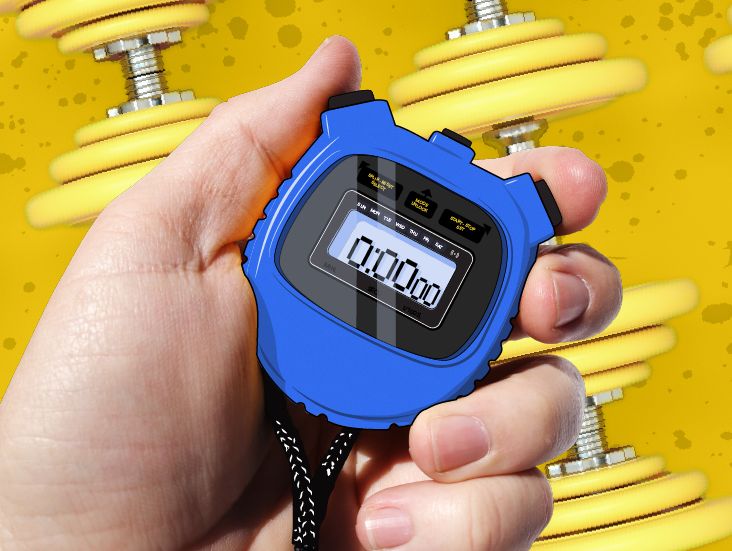
Honestly, hanging with a group of CrossFitters can feel like hanging with a group of doctors. (No shade, y’all!).
The special lexicon, niche references, and insider terminology make the convo, at best, tough to relate to and, at worst, totally over your head.
As such, it might feel impossible to get CrossFit questions answered by the Kool-Aid drinkers in your social sphere. That’s why we put together this CrossFit FAQ guide.
Ahead, we answer 10 crucial CrossFit questions with language even a novice can understand.
Walk into any CrossFit box and you’ll see a sign that reads: CrossFit is constantly varied, function movement, executed at high intensities.
Let’s break that definition down into its parts.
Constantly varied refers to the fact that you will rarely see the same workout twice. Consider it the least boring workout regime in existence.
“Functional fitness describes movements that are highly transferable and will train you to do other real world tasks,” explains CrossFit Games athlete Patrick Vellner, 4-time podium finisher and ambassador with QALO, maker of silicone rings and accessories for your toughest workouts.
In basic terms, that means it trains you to safely do day-to-day things like pick up packages from your front stoop, give your kiddo piggy back rides, throw a Frisbee to your Fido, and even sit on a toilet late into your life.
How are these exercises different from the ones you’d see in a group fitness class like Orange Theory or Barry’s Bootcamp? Good question.
CrossFitters train using compound dynamic movements like squat cleans, snatches, thrusters, and bar muscle-ups, which use multiple muscle groups and joints at once.
“These movements are different from the single-joint or single-muscle isolation movements that are traditionally done in sports like bodybuilding,” explains Vellner.
The high intensity portion of the definition refers to the fact that the exercises are completed, most often, at a high intensity. (Think a 7-plus on a scale of 1 to 10).
The new CrossFit definition
In 2019, the modality underwent a rebranding as then-CEO Greg Glassman tried to shift the public perception of the sport away from the competitive perception it had on ESPN, and back toward the more general public. Since then, the website defines CrossFit as a lifestyle characterized by safe, effective exercise and sound nutrition.
While not many CrossFitters use this new definition, ultimately, how the sport is defined will depend on whether you’re asking an old-dog or a fresh blood in the game.
Admittedly, the CrossFit definition doesn’t give you much info on what you actually do in a CrossFit class. Don’t worry, we’ll explain.
Essentially, a CrossFit workout cherry-picks the best parts of other sports and blends them together into one.
“It basically combines gymnastics, cardio, and weightlifting all put into one,” says Hayley Adams, 6-time CrossFit Games participant and 2021 Fittest American Woman. “In other words, it’s the best of many worlds.”
CrossFit combines components of each of the following:
- running
- rowing
- cycling
- Olympic lifting
- kettlebell training
- powerlifting
- bodybuilding
- plyometrics
- parkour
- and more
All in all, the goal is to help folks improve in nine different buckets of fitness: cardiovascular and respiratory endurance, stamina, strength, flexibility, power, speed, coordination, agility, balance, and accuracy.
Social media and ESPN might trick you into believing CrossFit is all rope climbs, tire flips, ring acrobatics, and heavy ass lifting.
But it’s exceptionally rare for these movements to make an appearance in class.
Movements that are common in CrossFit workouts include: squats, deadlifts, thrusters, pull-ups, rowing, (assault) biking, burpees, box jumps, push-ups, and pistols.
Typically, CrossFit workouts combine two to three (sometimes more!) of these movements into as many reps as possible (AMRAP), every minute on the minute (EMOM), or a chipper-style format (chipping away at a list of exercises).
If these movements sound intimidating to you, take comfort in the fact that they can all be scaled to different variations.
“The scalability of CrossFit is one of its biggest strengths,” says Vellner. “Any movement workout can be modified to meet someone at their fitness level and offer a great challenge to the most skilled or most amateur of athletes.”
Every CrossFit class will be different based on the style of the specific coach(es), as well as the style of programming your box offers.
But most classes last 60 minutes and follow the same general structure:
- dynamic warmup
- skill or strength
- workout of the day (WOD)
- cooldown or stretch
Of course, you’ll want to know if the workout you’re dedicating time and effort toward will be worth it.
Ultimately, the answer depends on what criteria you use — whether you want to meet personal health goals or just challenge yourself for a stretch of time.
But given that CrossFit has been widely known to support healthy weight loss, fat loss, strength gains, mobility and agility, and mental well-being, it’s safe to say that you can get some benefit from it.
(See a complete breakdown of the CrossFit benefits here).
Any high intensity fitness regimen is bound to have some folks questioning its safety. But CrossFit comes with no more risk than any other type of physical activity.
To limit injury risk, do your best to do the following:
- Make sure your first ever CrossFit gym has an onboarding program.
- Prioritize proper form over weight… always.
- Leave your ego at the door.
- Talk with your coach or health pro about any preexisting conditions and nagging injuries you may be navigating.
- Don’t ignore any lingering issues, but get them checked out by a physical therapist.
Despite what you may have heard, CrossFit isn’t just for the strongest, fittest, or most competitive among us.
“It can be a good fit for anyone,” says Vellner. Specifically, anyone who wants to get fit and/or healthy.
But, he says, there are two major groups in particular who most benefit from the training style.
“First, people who are competitive, either with themselves or others,” he says. Think: former or current college athletes, board game victors, and mini gold menaces.
“And second, people who might be a little bit intimidated to start their fitness journey and would benefit from the welcoming community environment,” he says. In particular, people who are motivated (not intimated!) by group-style training.
To determine if you’re a good candidate for CrossFit, ask yourself the following:
- Am I a competitive person?
- Am I motivated by the leaderboard?
- Do I perform best in group settings?
- Am I hoping to make friends while I exercise?
First, if you’re hesitant about trying CrossFit because you’re concerned that it might make you look a way you don’t want to look, we get it. But if you think having muscle mass in general is bad, it’s not, no matter your gender. On the contrary, having muscle mass is healthy!
But to answer your question directly: No, taking classes at your local affiliate alone will not make you “bulky.” Achieving a Hulk bod requires lifting (really!) heavy, (very!) often. It also requires that you eat with the goal of increasing muscle mass.
CrossFitters who you might describe as “bulky” spend hours exercising and fueling their bodies for optimal performance. It didn’t happen by accident!
Nope!
Over the last two decades, the CrossFit community has rallied around different eating plans for short bursts of time. First, they were *heart-eyes* for the Zone Diet. Then, there was a paleo craze.
These days, some members — especially people with performance or aesthetic goals — count their macros.
But rest assured, there isn’t widespread rallying around a specific eating plan the way there once was.
That said, if you do want nutritional support, many gyms partner with a local registered dietitian who can offer nutritional advice to members. There are also companies like M2 Performance and Tactic Functional Nutrition, who primarily work with CrossFitters.
This is a great question.
CrossFit is not a franchise like McDonald’s or Burger King — it’s an affiliate. That means, unlike those aforementioned fast food joints that have to meet certain “standards” of operation, CrossFit does not.
There are no specific guidelines for opening, programming for, nor decorating a box. So, all boxes are drastically different.
Different isn’t bad (yay, options!). But it does mean you’ll have to spend some time noodling on what you want in your CrossFit box.
Ask yourself:
- What is my goal? To make friends? To work toward Semifinals or the Games?
- When do I want to take a class? How far am I willing to drive to get there?
- What kind of coaching do I respond best to?
- Does the box have the kind of amenities I need?
Above all, though, take the time to drop into at least three of the boxes nearest you. This can help you see if you vibe with the general membership and coaching styles.
If you do decide to try CrossFit, “be kind to yourself and enjoy the ride,” says Vellner.
And if you can, give yourself the freedom to make friends while you’re there. “CrossFit is a really supportive community to be a part of,” he says.
“If you’re interested in trying out, just go for it! You won’t regret it.”
Gabrielle Kassel (she/her) is a queer sex educator and wellness journalist who is committed to helping people feel the best they can in their bodies. In addition to Healthline, her work has appeared in publications such as Shape, Cosmopolitan, Well+Good, Health, Self, Women’s Health, Greatist, and more! In her free time, Gabrielle can be found coaching CrossFit, reviewing pleasure products, hiking with her border collie, or recording episodes of the podcast she co-hosts called Bad In Bed. Follow her on Instagram @Gabriellekassel.





